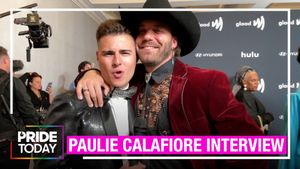Make no mistake:
Closet doors are wide open in the '90s--and
every activist's wardrobe, from Gucci to the
Gap, tells a different story. Still, in the overall
stylistic scheme of things, proper activist fashion
boils down to one simple yet complex design dilemma: to
differentiate or to assimilate. For the good of the
gay and lesbian community's image, is it better
to take to the streets in tuned-up leather and latex or in
toned-down khakis and cashmere? And on the rocky road to
equality for all, does fashion really make a
difference?
For years the gay
activist fashion focus has been mostly assimilationist;
blending in with the smart straight style set has been a
political priority. We've all heard speeches
that promise gay empowerment if only the community
would fit in, play the game, and promote polite pacifism
over punk pugnacity. But after California governor Pete
"Paraiah" Wilson's venomous Veto
of AB 101, a bill that would have banned antigay job
discrimination, many say it's a brand-new ball game.
And fashion--that mirror of the moment--is
stepping center stage in the brouhaha.
The hard-core
Calvin Klein-draped contingent still believes in
nonthreatening activist wear, while the angry militant
faction prefers crass to class any demonstration of
the week. In my opinion, the bottom line is
queer-clear: Each couture camp, from the dress-for-success
gay and lesbian mainstream leaders to the outrageous
AIDS Coalition to Unlease Power (ACT UP) and Queer
Nation crowd, possesses its own positive and negative
fashion facets. Take a gander at the good, the bad, and the
downright ugly in contemporary activist wear. In a world
hell-bent on making an unforgettable fashion
statement, some of those outfits really
do speak louder than words.
First up: two
powerfully provocative activist groups, ACT UP and Queer
Nation. Although their political agendas may be
theoretically different, their fashions are, for the
most part, equally newsworthy. With attention-grabbing
getups ranging from basic postnuclear rags to rarefied
space-age drag, these rowdy rebels are causing much more
than a mere couture commotion. Not since the Black
Panther/women's liberation/Stonewall days has
activism mixed fashion and politics to such galvanic
effect. Bogged down in Doc Martens just made for marching,
tight T-shirts, torn 501s, logoed leather bombers,
tacky tattoos, and the occasional nose ring for that
fresh-out-of-the-hardware-store savoir faire, these
activists have adopted an aesthetically mind-boggling look
that grabs the media spotlight with Day-Glo intensity.
Unlike
conservative mainstreams who prefer demure dialogue over
down-'n'-dirty demonstrations, these fashion
faux pas not only dance to a different drummer but
also conduct a stylistic symphony all their own. Most
of the notes are forgettably flat; others, like ACT
UP's stark, simple, and stunning SILENCE =
DEATH black-and-pink triangle logo, magnificently
bridge the gap between creativity and credibility. By
refusing to blend in with the homogenized masses, by donning
jaw-dropping duds that spit in the airbrushed face of
"acceptable" fashion, and by inventing
an indelible look to frame their revolutionary message, ACT
UP and Queer Nation activists know that one picture
equals a thousand words. People gape, people
criticize, but people remember. And
if sending a message loud and clear is paramount in
today's sound-bite society, then these metal-clad
militants are the new masters of media manipulation. Shock
sells--and if you don't believe me, just
ask Cher.
According to
Warren Windsor, a member of both groups' Los Angeles
chapters, "We're antiestablishment and
couldn't care less what anyone thinks about
what we wear. Like the logo says, ASSIMILATE MY
FIST."
Well! Somehow I
just knew he wasn't related to the duke and duchess
with that fashion attitude.
"Besides," Windsor continues, "some of
our demo fashion is based on necessity. Our
shit-kickers [hard-toed black boots] protect our feet from
police horses. Shaved heads keep the cops from grabbing our
hair."
I didn't
want to ask what the nose rings prevented.
"ACT UP
and Queer Nation really have two different looks,"
Windsor kindly clarifies in an educational tone even
Armani would love. "ACT UP is about SILENCE =
DEATH. It's a very powerful symbol. Queer Nation is
probably a more militant look: black leather jackets,
lots of stickers and slogans, bandannas,
gender-fucking garb..."
Oh, dear. Yet
despite Queer Nation's "wear whatever turns
you on" declaration of fashion independence,
its cornucopia of kitsch (hair spray, Ace bandages,
frocks, socks, pumps, mustaches, fishnets, latex,
tiaras, and ties were all suggested accessories for a recent
protest in Hollywood) remains a definite uniform unto
itself. Beyond bizarre is the status quo--no
pretentious polo ponies or over-the-hill alligators in
pectoral sight. And with slogans like BUTCH CHICKS AGAINST
POWER-MAD DICKS, QUEER LIBERATION NOT ASSIMILATION,
and my favorite, GLAMORIZE DON'T MILITARIZE
emblazoned across every square inch of available fabric,
classic understatement has hit the skids faster than Milli
Vanilli.
Naturally Windsor
approves. "Our fashions reflect an outre
attitude that's bound to attract not only
potential members but to pique the interest of the
press too," he explains.
Like I said, this
is one smart and savvy group. As for new and noteworthy
trends on the homo horizon, Windsor notes that increased
"gender-fucking clothes that trash
heterosexism" and "piercing as a gay
adornment" loom ahead. I can hardly wait. In
summing up the collective look for both out-there
groups, Windsor says the overall theme is "no
business as usual." Touche--the
direct-action way.
Speaking of
direct action, in Houston the question "Can I give
you one of these?" may reverberate from a dark
downtown street corner at 3 A.M. or from outside a
safely suburban high school football stadium at dusk, but
to Brian "Condom Queen" Bradley, the scenic
details are irrelevant. However, his dedication to
AIDS prevention through condom distribution and
education is not. In Bradley's case, differentialist
fashion takes on a unique pharmaceutical flair,
culminating in condom-based accessories of his own
design.
"Fashion
has an important place in gay activism," Bradley
contends. "It serves as a catalyst for people
to hear you. I'll do anything to keep attention
on the subject of condom usage."
Bradley, who has
tested HIV-positive, fights for the rights of all
infected people and often wears homemade condom earrings and
a T-shirt reading HIV+, which he feels lends dramatic
credence to his safer-sex crusade.
"I want
people to know that fact about me," Bradley explains.
"If they know I'm HIV-positive,
they'll listen. I'm determined to keep the
issues out there, and my clothes are a constant
reminder."
Although most
comfortable in a plain T-shirt, a SILENCE = DEATH button,
jeans, boots, and his omnipresent cache of latex lifesavers,
Bradley has been known to haul out the proverbial tutu
for media-drenched public marches. "Drag will
always have a place in the gay rights movement," he
predicts. "It really grabs public attention. Remember
Stonewall?"
Yes, I do. And so
does Ggreg Taylor in San Francisco, the next pit stop
on our taffeta-and-tattoo fashion tour.
In the GLAMORIZE
DON'T MILITARIZE department, business is hardly usual
for drag activist Taylor, whose "glamour
assaults" on Golden Gaters make Madonna look
positively provincial. Although his closet is a veritable
vault of fashion fantasies, encompassing noncategorical
styles swirling from mod prim to glorious MGM, Taylor
makes clear that he is "no Jim Bailey."
This dolled-up diva of drag outreach dismisses the
entertainment-oriented illusionist label with a wave of his
diamond-circled wrist. He much prefers putting a socially
relevant Stonewall spin on age-old cross-dressing,
saying, "I'm a postmodern drag
queen--everything I do is political."
To Taylor the
kind of kaleidoscopic fashion activism he espouses
"creates an undeniable queer visibility. When
queers are hidden, they become
mystified."
In other words,
no cozy cashmere cardigans for this rhinestoned
revolutionary. "If wearing a sweater is
someone's idea of moving forward,"
Taylor theorizes, "then they've got the wrong
idea of what moving forward is."
Taylor believes
his "in-your-face, hands-on" activism forces
"public officials to deal with the
issues"--if, in fact, they not blinded for life
by the sheer wattage of his wardrobe. In addition to an
Imelda-like fetish for fine footwear
("I've got better shoes than anybody,"
he defends), he's also environmentally
responsible, noting that "the best thing about
drag is that it's recyclable. It also differentiates
you from the rest of the planet."
And how!
Let's face it: In pink sponge rollers and majestic
mirrored platforms, Taylor is hard to miss--and,
according to his political plan, impossible to
ignore.
Back in
fashion-frantic Los Angeles, the very stylish Torie Osborn,
executive director of the Gay and Lesbian Community Services
Center, takes a smart middle ground in the couture
controversy. Osborn feels activist wear
shouldn't be confined to a singular style or rigid
dress code. She also has a few qualms about the high
profile that demo fashion plays in general.
"Gandhi did fine without a fashion
consultant," she says with only a tinge of
tongue-in-cheek irony.
Ah, yes. But some
will say Gandhi wasn't living in the age of Oprah,
Phil, and Geraldo.
"Let's let people be who they are,"
Osborn continues. "When you're building
a movement, it's important to be yourself. This shows
our pride and creativity."
To Osborn, the
key to successful activist fashion is old-fashioned
diversity. "If we're going to a
civil-disobedience action demonstration," she
says, "it's important to see the clergy
wearing their collars and to see leadership in suits.
We should project to mainstream America that part of
our diversity. We're in corporate America as well as
on the streets. I don't want a holier-than-thou
attitude that says you're not a real activist
unless you wear a T-shirt. That's movement-fashion
fascism. We have to be more visionary than
that."
Yet despite gay
and lesbian critics who rave that the New Age radicals
are setting the movement back a decade, Osborn is quick to
praise ACT UP and Queer Nation for bringing a
"harder-edged gay sensibility" to '90s
politics. "ACT UP has brilliantly used the
media," she lauds. "If it hadn't
been for ACT UP, we'd have very little AIDS related
government funding."
Across the nation
in Washington, D.C., Urvashi Vaid, executive director
of the National Gay nd Lesbian Task Force, a political
group, adds that ACT UP's effective
"visual presentations" via dramatic
"posters and symbols" have a potent and
memorable political impact.
Vaid also mirrors
Osborn's fashion-diversity dogma to a democratic T.
She confides that in the office she is all mainstream
East Coast "execu-drag. In certain forums this
look functions best." Demonstrations, however,
bring out the denim in her. The evolutionary process of
modern lesbian and gay fashion piques her interest as
well. "In the early '80s," she
recalls, "we dressed a certain way to identify
ourselves to each other. Now in the '90s,
we're dressing to show the world who we are."
From what she
terms "button-down suit-and-tie activists" to
"leather-jacketed, boot-clad" demonstrators,
it's an option-packed parade of possibilities
Vaid finds creatively and politically appealing.
Business-suited
Rich Jennings, executive director of the Los Angeles
chapter of the Gay and Lesbian Alliance Against Defamation,
a media watchdog group, heartily approves of the new
cutting-edge look, although he laments that in these
recessionary times, "I only wish I could afford
it. It's a lot more fun than what I'm wearing.
But I'll have to content myself with an old
earring." Call Warren Windsor,
Rich--he'll get you a set of safety pins
wholesale.
In wrapping up
this wardrobe war of who's right and who's
wrong, it seems both fashion camps have their merit,
working best in concert with one another. Yes,
it's hard to march in fabulous Ferragamo flats, but
it's also hard to push pens in bargain-basement
combat gear.
Assimilators use
fashion benignly--artfully blending chic threads to
appealing, nonthreatening, and, at times, positive political
effect. They're content to let their deeds
speak louder than their duds, although a few, I fear,
tend to fade into Capitol Hill's heterosexual
woodwork. Regardless, groups like the American
Foundation for AIDS Research have done gobs of good,
and you don't see Mrs. Fortensky tattooing her
celebrated cheeks. (Of course Old Violet Eyes doesn't
have to--she's a PR queen nonpareil.
Meanwhile, the
once-invisible, outside-the-system angry gay activists
have demanded attention and succeeded in spandexed spades.
Now, however, they run the risk of self-parody--
a definite no-no in cutting-edge politics. The big
question is whether they'll evolve beyond the shock
frocks or simply continue to pierce themselves into a Swiss
cheese-like oblivion. I do hope they're up to
the fashion challenge. After all, it takes all kinds
to part the homophobic waters.
I think Coco
Chanel said it best: "In order to be irreplaceable,
one must always be different." And acceptance
of those wondrous differences, from Melrose glitz to
Manhattan ritz, epitomizes the freedom all of us are
fight--and dressing--for.


















































































